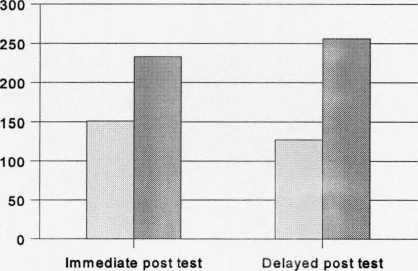5.4.2.2.6 Sentence generation task
Scoring criteria for the sentence generation task
Each child was asked to make up two sentences which included the target words. To be
scored correct, the child had to use either the target word or an acceptable alternative (e.g.
pronouns) in an appropriate sentence context and incorrect the use of the new word in an
inappropriate sentence context or a “don 't know” response. For the present experiment an
appropriate sentence context had to include any of the following information about the target
words: a) perceptual e.g. the abez is long, thin with holes b) functional e.g. the boy plays
music with the abez c) semantic e.g. the feber is a house. Each child could get a maximum
score from 0-2.
Analysis
If all children were correct on the two target words, the maximum total score would be 384
for all the participants in each post test. Figure 5.18 below shows children’s performance on
the sentence generation task for both post tests. As the Figure shows, 233 of children’s
responses were appropriate sentences during the immediate post test, while 256 of their
responses were appropriate sentences in the delayed post test.
Figure 5.18 Children’s performance on the sentence generation task for both post tests

I I Don't know∕irrelevant responses
И Appropriate sentences
To what extent does children's performance on the sentence generation task differ by age ?
If all children from each age group were correct on the two target words, the maximum total
score would be 128 for each age group in each post test. Figure 5.19 below demonstrates
children’s performance on the sentence generation task by age for both post tests.
160
More intriguing information
1. The name is absent2. The name is absent
3. Inflation Targeting and Nonlinear Policy Rules: The Case of Asymmetric Preferences (new title: The Fed's monetary policy rule and U.S. inflation: The case of asymmetric preferences)
4. The name is absent
5. The name is absent
6. The name is absent
7. The name is absent
8. The ultimate determinants of central bank independence
9. TOWARD CULTURAL ONCOLOGY: THE EVOLUTIONARY INFORMATION DYNAMICS OF CANCER
10. The name is absent